EXT Aria
MSRP: €1,060 / $1,150 USD
Adjustments: Main and secondary air pressure; rebound; low- and high-speed compression; hydraulic bottom out
Blister’s Measured Weight: 658 g (230 x 65 mm, w/o mounting hardware)
Reviewer: 6’, 175 lb (183 cm, 79.1 kg)
Test Duration: 3 months
Test Locations: Washington, British Columbia
Bolted to: Nicolai G1
- 210 x 50 mm
- 210 x 52.5 mm
- 210 x 55 mm
- 230 x 57.5 mm
- 230 x 60 mm
- 230 x 62.5 mm
- 230 x 65 mm
- 250 x 67.5 mm
- 250 x 70 mm
- 250 x 72.5 mm
- 250 x 75 mm
- 185 x 50 mm
- 185 x 52.5 mm
- 185 x 55 mm
- 205 x 57.5 mm
- 205 x 60 mm
- 205 x 62.5 mm
- 205 x 65 mm
- 225 x 67.5 mm
- 225 x 70 mm
- 225 x 72.5 mm
- 225 x 75 mm
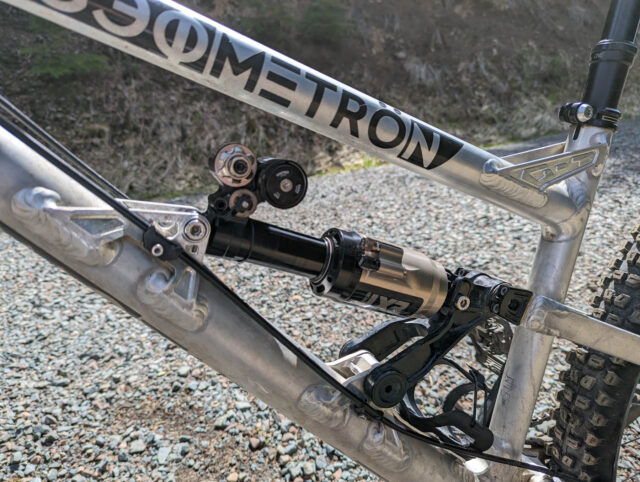
Intro
EXT’s coil shocks have been deservedly-popular high-end options for some time now; we’ve been impressed with a number of iterations of the Storia, as well as the Arma MX that we tested on the Canfield Jedi last year. Today they’re launching their first air-sprung mountain bike rear shock, the Aria — or simply “Air” in Italian.
While the Aria is EXT’s first air-sprung mountain bike shock, it’s not like they don’t have experience working with air springs, dating back to some work with the Williams F1 team quite some time ago, and more recently, the Era MTB fork. If you want to hear a whole lot more about the history of EXT and their philosophy on suspension design, check out Episodes 110, 140, and 146 of Bikes & Big Ideas with their founder, Franco Fratton.
We first saw prototypes of the Aria in person at Sea Otter 2022 and with the 2023 iteration of the show just around the corner, the Aria is now available to the public (and we’ve got one on the way for review). But what’s going on with the design of the Aria, and what sets it apart from the many other options for a high-end air-sprung shock? Let’s have a look.

Design
The Aria is a high-volume air shock meant for Trail through DH bikes (and is offered in a range of metric sizes in both standard and trunnion mounts to suit, as listed above). Perhaps the most interesting bit about the Aria’s design is the air spring itself. Like most modern air shocks, the Aria has an adjustable positive air spring with a self-equalizing negative chamber. But unlike just about every other rear shock I’m aware of (the Chickadeehill LFB6, which I’ve never so much as seen in person, being the lone exception), the Aria adds a second independently-adjustable positive chamber to the mix.
[If a refresher on what we’re talking about with positive and negative springs would help right now, our Vorsprung Secus review has a detailed rundown.]
The secondary positive chamber in the Storia takes the place of the volume spacers that most air shocks use to tune the amount of progression in the spring, and in doing so produces somewhat different results. In short, the secondary ramp-up chamber is separated from the main positive air chamber by a floating piston and is set to a much higher pressure. When the shock starts to compress, the main positive chamber compresses until its pressure reaches that of the ramp-up chamber, at which point the piston separating the two starts to move and both compress in unison. In effect, this turns the two into a single higher-volume chamber that ramps up more slowly from that inflection point onward.
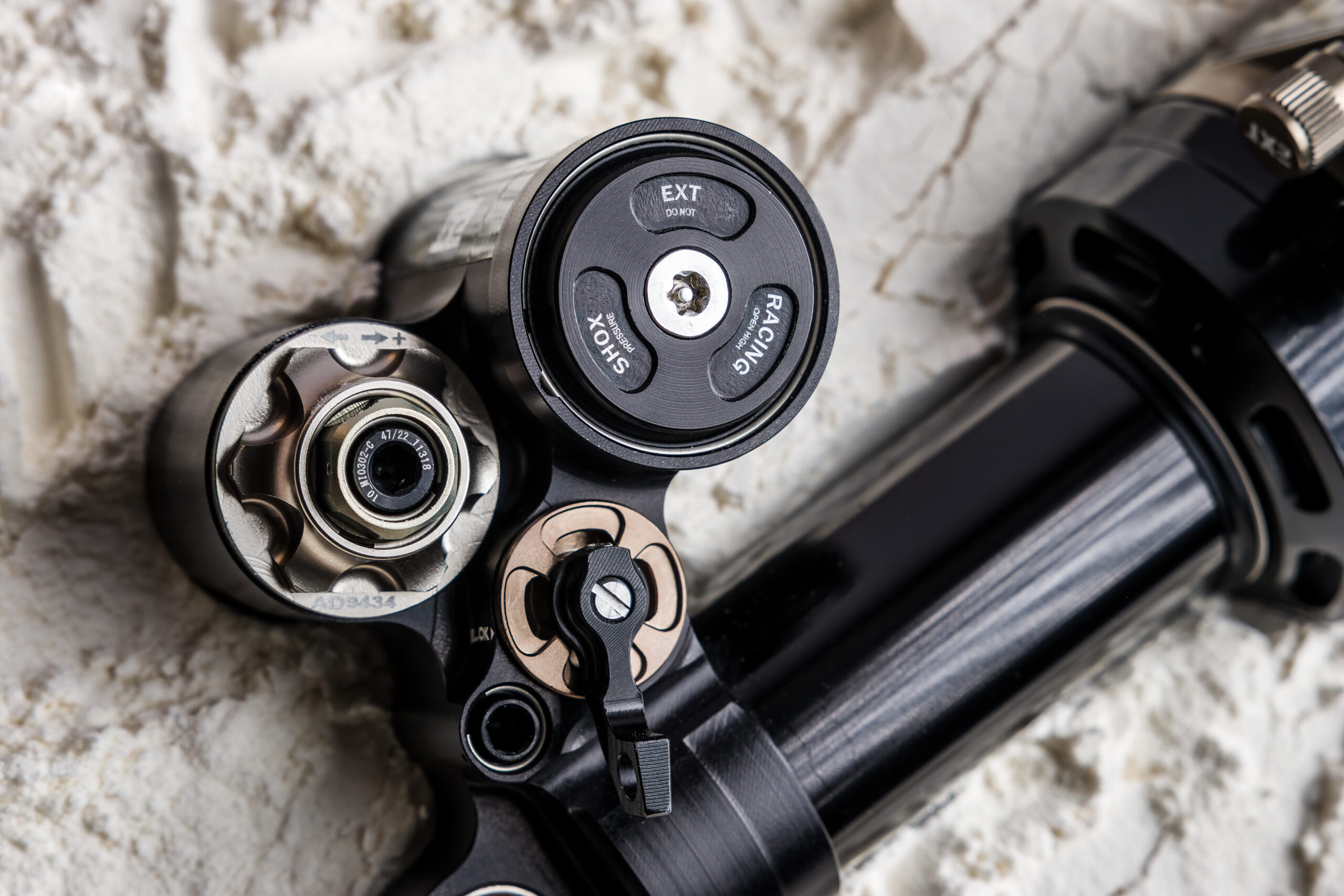
The idea is that this arrangement (EXT calls it “HS3”) makes for a more linear, coil-like spring curve with more midstroke support than a conventional air spring design, while still having the adjustability and ability to tune the overall amount of progression that you get from an air shock. The greater the difference in pressure between the main positive chamber (labeled “+” on the Aria) and the ramp-up one (“++”), the deeper in the stroke the two start to move in unison, and therefore the more the spring ramps up through the midstroke. That’s somewhat in contrast to the more typical volume spacer arrangement in most air shocks, which have more of an effect late in the stroke. EXT has some nice graphs that illustrate the differences in spring curves, both between altering volume spacers in shocks that use those, and in separately changing the + and ++ pressures in the Aria. EXT says that riders can more precisely target the behavior they want in a specific part of the stroke with greater ability to fine-tune performance and with fewer effects on other parts of the stroke than is possible with a more conventional volume spacer arrangement.
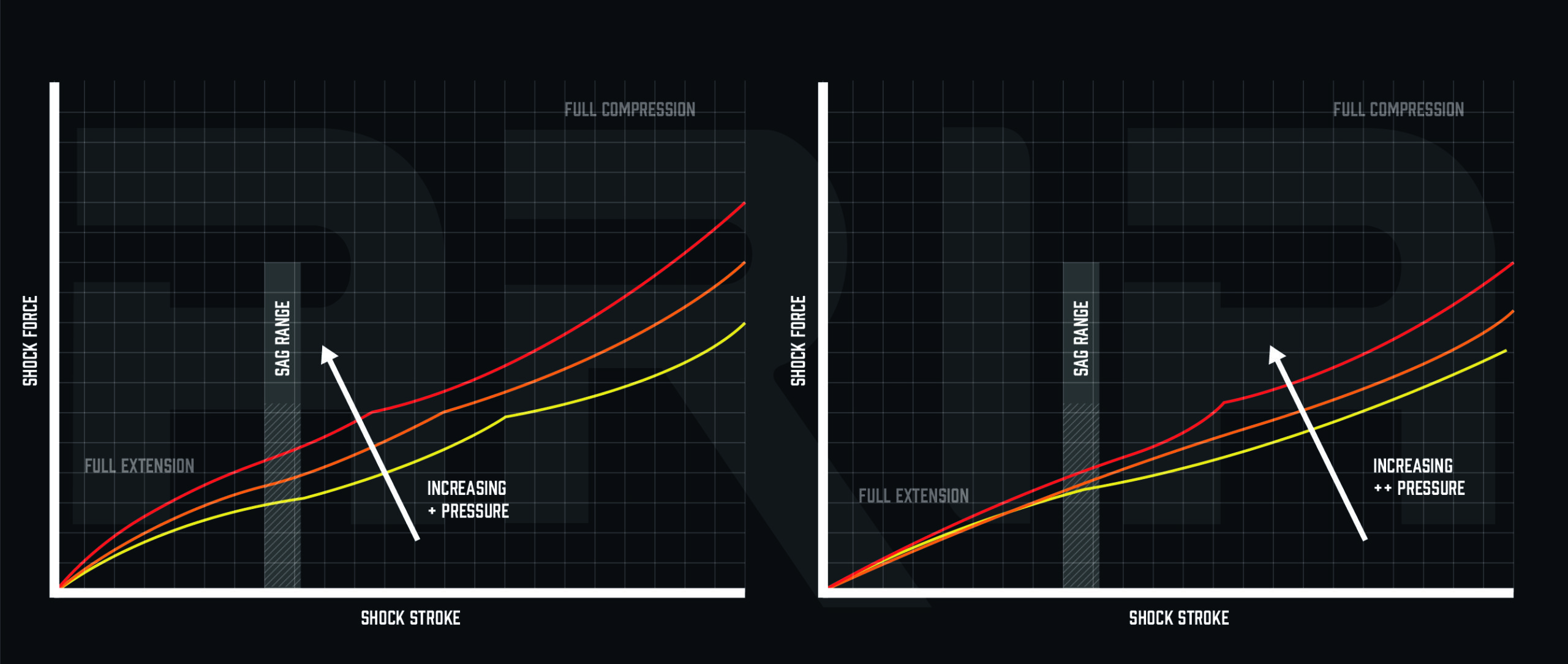
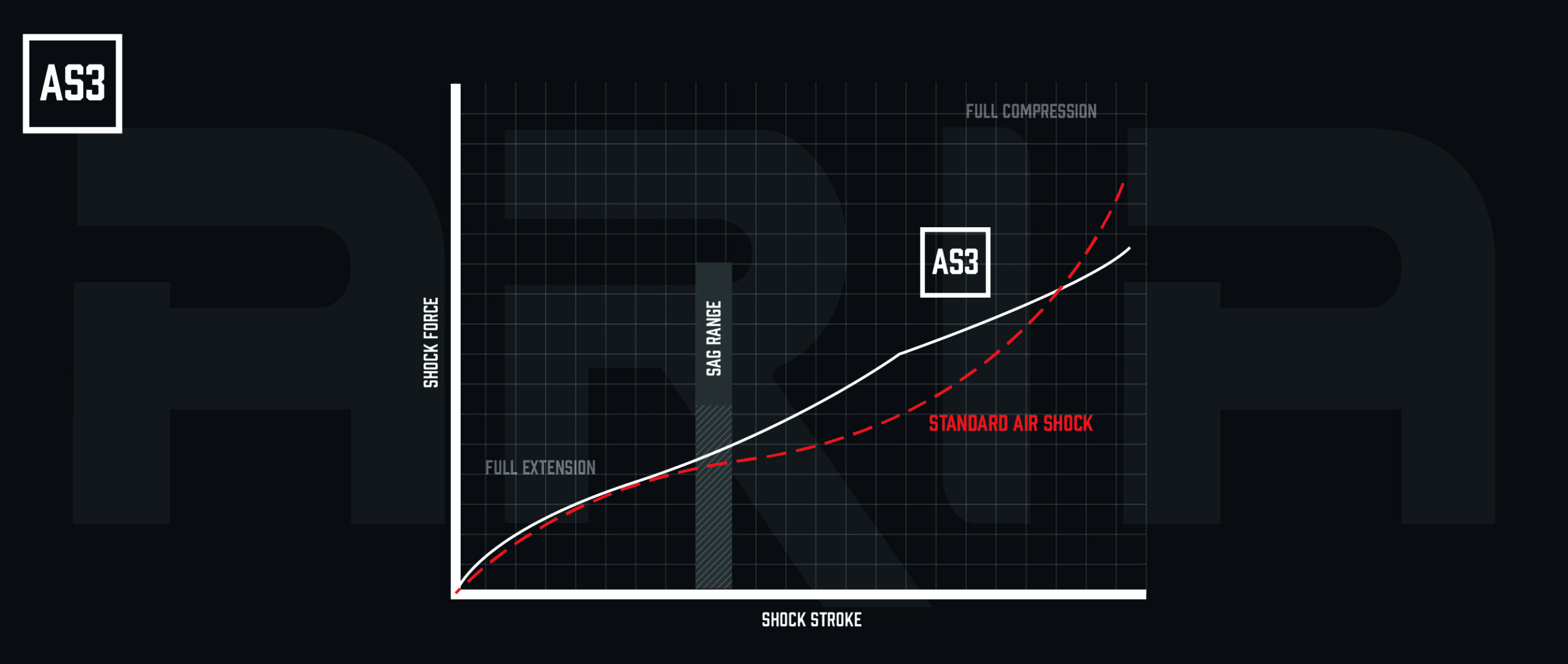
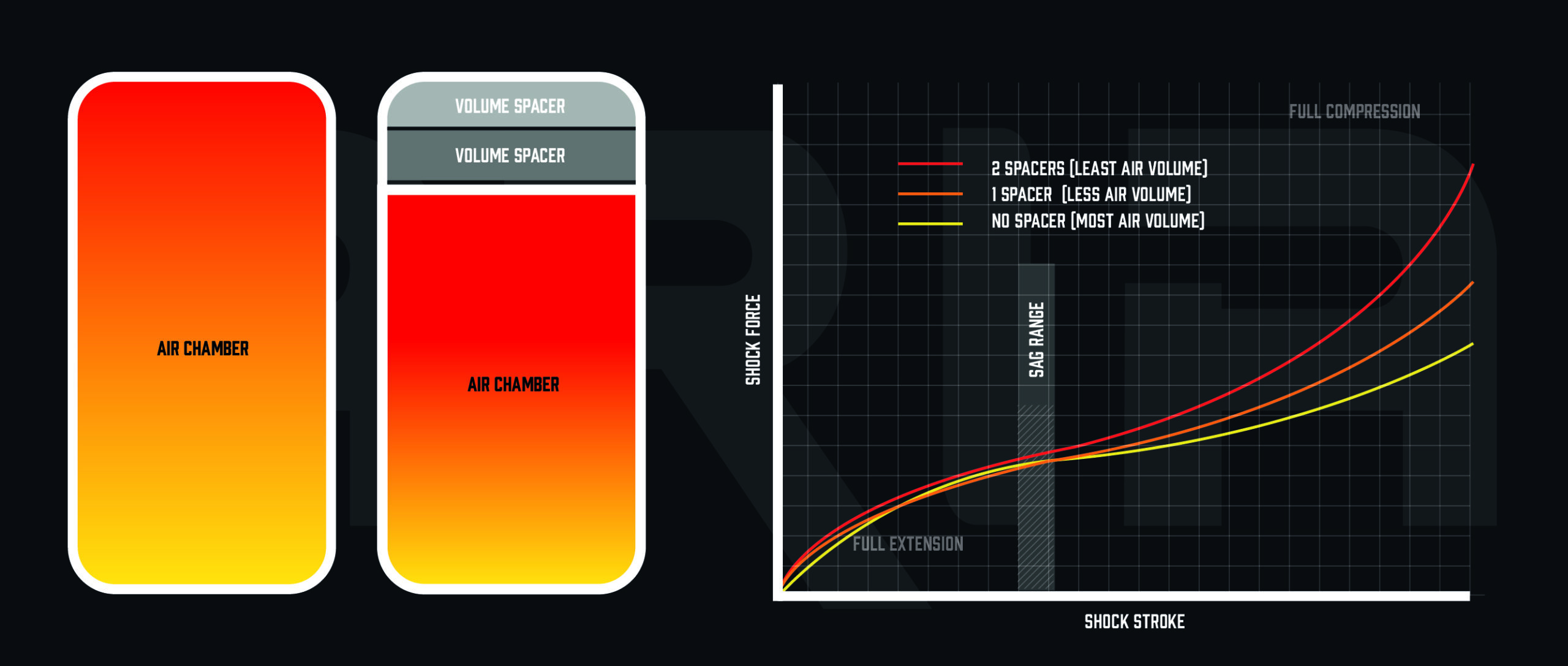
I’ve been a big fan of this style of dual-positive air springs in a variety of forks over the years, including EXT’s own Era, and a few other forks from Manitou and Ohlins, so I’m quite curious to see how it pans out in a rear shock. EXT also says that they’ve managed to package all of that with just two dynamic seals separating the three separate air chambers in an effort to reduce friction, and have paired that with a proprietary surface coating on the sliding parts for especially smooth operation. The Aria also uses EXT’s newly-formulated EV2S damper fluid, which they say has especially consistent performance across a wide temperature range to reduce damper fade.
The Aria’s damper is based on the design of the e-Storia but reconfigured for use in an air shock. It’s a monotube design with adjustable rebound, low- and high-speed compression, and an externally adjustable hydraulic bottom-out circuit that increases compression damping in the final 15% of the stroke. The idea here is to provide speed-sensitive bottom-out resistance that increases damping when the shock is near bottom-out and still compressing quickly; this arrangement also has the benefit of not returning the energy that it absorbs to the rider on rebound in the way that a spring (or bottom-out bumper) would.
The Aria also features EXT’s Lok 2.0 climb switch, which, when activated, directs oil flow through a secondary compression circuit with a preloaded valve for additional low-speed compression damping to improve pedaling efficiency. The Lok switch’s damping isn’t externally adjustable but can be re-valved as part of a regular service if desired.
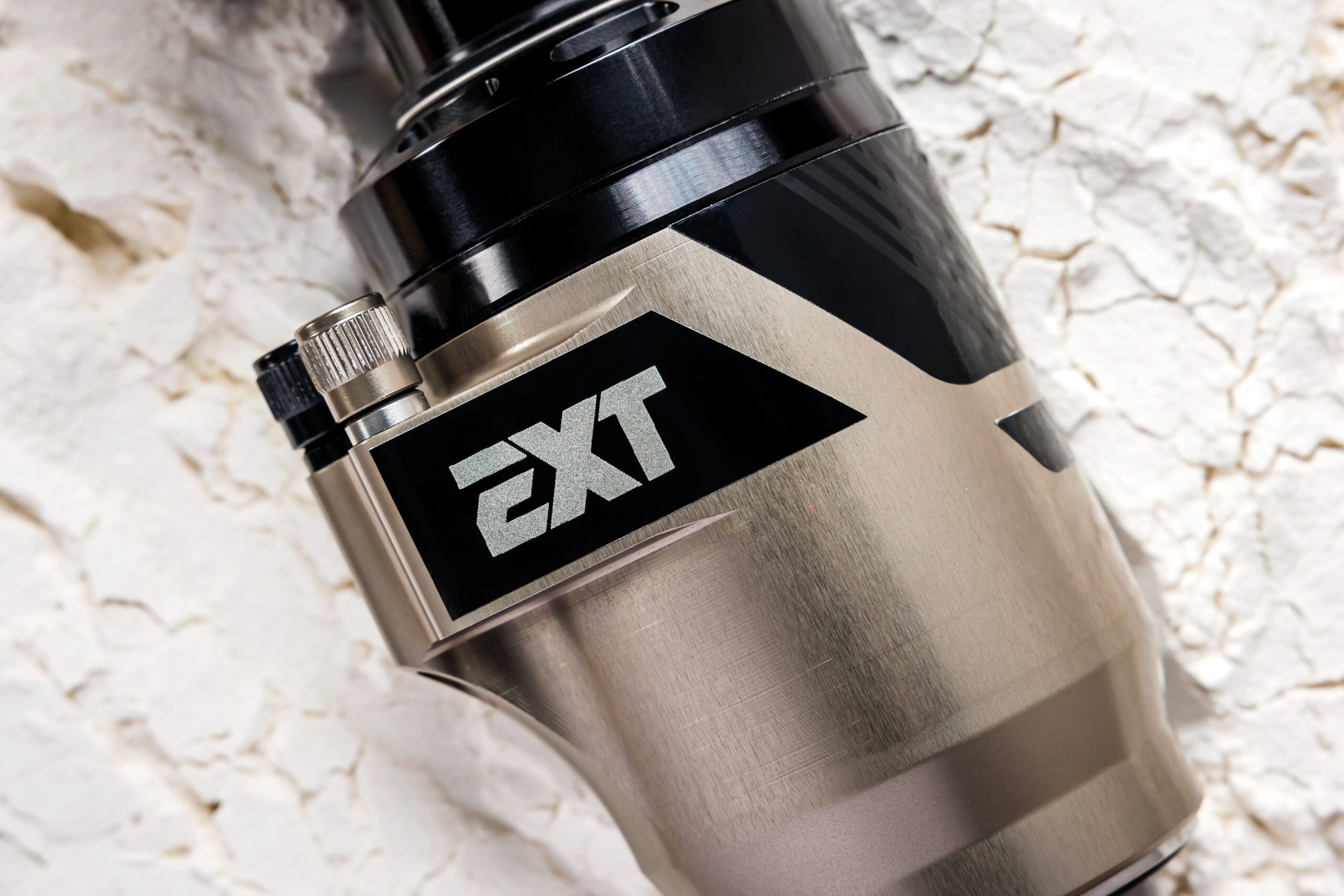
Some Questions / Things We’re Curious About
(1) How is the dual-positive chamber HS3 air spring going to work in a rear shock? We’ve been consistently impressed with similar designs in forks, but will it translate to a very different package?
(2) And how is the Aria going to stack up against its excellent coil-sprung counterpart, the Storia, and which one will work best for what sorts of riders? In theory, the Aria sounds something like a lighter, more tunable version of the Storia but is that borne out? (The Storia is also exceptionally light for a coil-sprung shock, so we’re curious to see how the Aria compares weight-wise. EXT hasn’t yet published a stated weight for the Aria but we’ll report back once we have one in hand.)
Bottom Line (For Now)
We’ve been very impressed with a number of iterations of EXT’s coil shocks over the years, so we are quite excited to see how the Aria stacks up. We’ve got one on the way for review, so stay tuned for much more on the Aria — including comparisons to the Storia — coming soon.
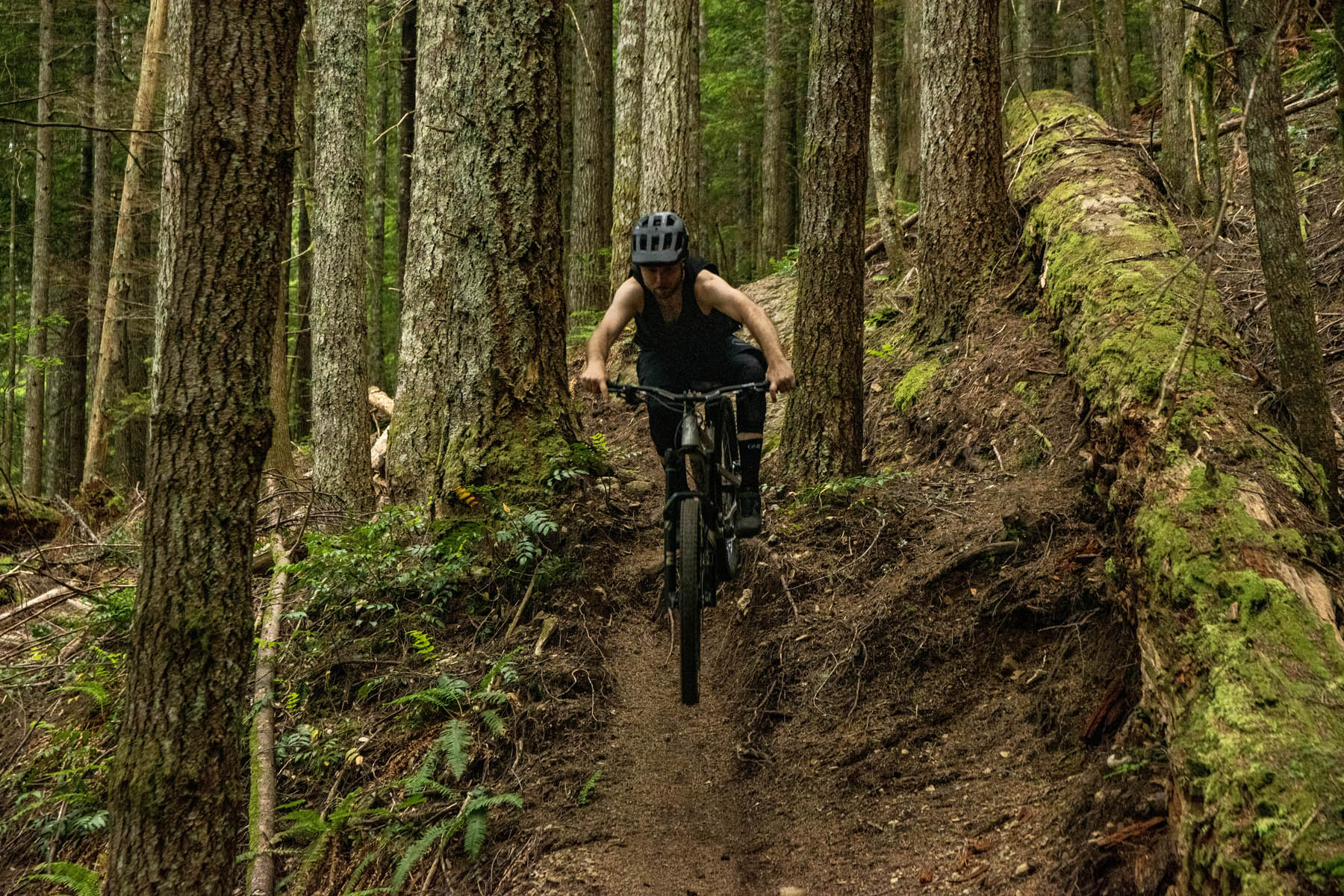
FULL REVIEW
EXT hasn’t been shy about the fact that they’ve been working on an air shock for quite some time now, and having had great experiences with a number of their coil shocks over the years, I had high hopes for how the Aria would perform. But I was also curious: would the Aria be able to compete with EXT’s exceptionally good Storia coil shock, and how would its unconventional dual-positive spring layout work in a rear-shock package?
Having now spent three months on the Aria, it compares very favorably to the other high-volume, gravity-oriented air shocks on the market, and does have some real advantages over the coil-sprung Storia as well, at least for certain riders in certain circumstances.
On the Trail
One of the other big questions I had going into this review was regarding the Aria’s setup. With two separate positive air chambers to fill and tune, was it going to be a headache to adjust and dial in, or would the process be relatively straightforward? Having now ridden quite a few dual-positive air-sprung forks, there’s a wide range among them in terms of just how sensitive they are to minor changes in air pressure settings, and I wasn’t sure what to expect from the Aria. But for the most part, I’ve found it to be quite easy to live with on that front.
EXT’s setup guide for the Aria goes by equivalent coil spring rate rather than rider weight. For folks who are setting up the Aria on a new bike, or replacing another air-sprung shock, that might not be the most helpful, but it’s also understandable that EXT isn’t comfortable basing settings off rider weight across a broad spectrum of bikes — off the top of my head, I’ve wound up running spring rates between 350 and 475 lb just on ~170mm-travel Enduro bikes that I’ve reviewed over the years, depending on the frame (and to a lesser extent, shock) in question. But if nothing else, the chart is helpful for giving a rough baseline for the ratio of pressures to run in the + vs. ++ chambers, and if you need help coming up with an approximate coil rate to start with as a baseline, your frame manufacturer or EXT themselves should be able to help.
In my case, since I’ve run several coil shocks (including EXT’s own Storia) on my Nicolai G1 review bike, I had a good idea of where to start on the chart. The suggested baseline setting of 190 psi in the + chamber and 370 psi in the ++ one, relative to my preferred 375 lb Storia spring rate, was indeed a very close starting point. If there’s anything that I found to be a little cumbersome about the setup process, it’s largely that the very high pressures required in the ++ chamber necessitate a special shock pump, since the typical 300 psi ones don’t readily go high enough. EXT includes a 600-psi-max pump with the Aria, but that pump is notably long and doesn’t really fit in a hip pack for on-trail adjustments during the initial setup period.
[Update: EXT has revised their maximum pressure settings for the Aria from the numbers that were printed in the manual that came with our test shock. The maximum pressure for the ++ chamber is 600 psi, and the + one tops out at 280 psi. Per EXT’s chart, that’s equivalent to about a 625 lb coil spring, which should cover a whole lot of riders on most bikes, but heavier folks on certain higher-leverage bikes might need to look elsewhere.]

That minor inconvenience aside, I found the Aria to be straightforward to set up, and not terribly demanding in terms of being ultra-precise when setting the two air chambers to still perform well. Increasing the pressure difference between the two makes the shock feel more supportive through the midstroke relative to its overall firmness and a little more progressive overall; doing the opposite makes it firmer and more lively off the top, and mellows out the ramp-up deeper in the stroke, but it’s not like you have to hit a really specific ratio to keep the spring curve from feeling wildly out of whack.
I think there’s room for reasonable disagreement here, but I personally find the dual-positive layout to be less laborious to experiment with than traditional volume spacers, too. It’s probably fair to say that the Aria’s layout might require a little more care to keep adjusted down the line, since volume spacers don’t need any further attention once you’ve got them dialed, but I also don’t find checking a second air pressure setting to be a big deal in the slightest once I’ve already gone to the trouble of getting a shock pump out for the first one.
Anyway, that’s a long preface to the punchline: the Aria is, simply put, the most coil-like air-sprung shock that I’ve tried to date. It’s got the added fine-tunability of the dual-positive air spring arrangement, and a subtle but noticeable additional ramp-up deep in the stroke from the air spring. The Aria still feels best suited to relatively progressive bikes, like those that would generally be considered coil-compatible — if you’re looking at an air shock specifically in search of a much more progressive spring curve than you get from a coil, there are better options out there. In particular, the Öhlins TTX1 Air or the RockShox Super Deluxe (with the lower-volume air can option) pair a high-end, highly-adjustable damper with an especially progressive low-volume air can; the TTX2 Air and higher-volume can on the Super Deluxe are notably more linear but still a notch shy of the Fox Float X2, and the Aria is yet another step up from there.
I’m focusing on the air spring so much because it really feels different from anything else I’ve tried to date. The Aria still has a subtle ramp-up deeper in the stroke that feels akin to a typical high-volume air spring, but does that while having far less of the soft portion around the sag point that air springs tend to display to one extent or another, and offers the ability to really fine-tune where in the stroke the ramp-up starts. Not everyone is going to want to do that kind of small-scale adjusting, but for the folks who are inclined to do so, and have a bike where a relatively linear, high-volume air shock makes sense, it’s a compelling arrangement.

In terms of the damper adjustment ranges, all four adjusters (rebound, low- and high-speed compression, and hydraulic bottom-out) have what I’d call a medium-wide adjustment range. I.e., enough to make very real differences in feel and performance, but not so broad as to leave a ton of room for a wildly off-base setup (provided that the base tune is appropriate for the bike and rider in question). EXT did an excellent job with our test shock on that front, leaving a good useable range across the board. Needing a 12 mm box wrench to adjust the high-speed compression is mildly inconvenient, but EXT now has a 3D printed mini tool that they include with the Aria to handle that job; the low-speed compression and hydraulic bottom out both take a 4 mm Allen wrench, and the rebound adjuster gets a tool-free knob.
[EXT founder Franco Fratton goes into a lot more detail on his philosophy on damper adjustment ranges, and why keeping them more narrowly tailored (within reason) has real benefits in Part 1 of our Very Deep Dive on Suspension podcast series over on Bikes & Big Ideas; you can also check out Part 2 and Part 3 for even more from Franco.]
Beyond just setup and tuning, the Aria’s damper has been quite impressive as well. Unsurprisingly, it feels quite reminiscent of the Storia damper (I haven’t ridden the e-Storia on which the Aria is more directly based). In particular, the Aria does an especially good job of being able to run relatively firm compression damping for a more composed, stable ride at speed without feeling particularly harsh or wildly over-damped on smaller impacts. Of course, we’re talking about a custom-built damper here, and I did request that EXT set it up along those lines — the Nicolai G1 that I used for the test is a big, stable bike that works best at speed on steeper, faster descents, and EXT did an excellent job of building a damper for that application. The Aria has also been consistent in its performance, with no appreciable fading or other foibles, even on some very long, rough descents, and has generally kept the rear end of the bike nicely controlled without doing anything to draw too much attention to itself, in a good way.
Going into the review I was very curious to see if I’d end up preferring the Aria or the Storia on the G1, and the answer isn’t at all cut-and-dried; there are pros and cons to both, and I genuinely can’t pick a definitive winner. The Aria’s small-bump sensitivity and compliance are excellent, especially for an air shock, but the Storia is lower friction and smoother of the top still (especially in the G1-specific version that comes stock on that frame, which features a coil negative spring; check out our full review on the bike for more on that). The Aria feels more supportive and controlled deeper in the stroke, and rides a little higher in a lot of dynamic situations (think high-speed mid-sized chop in particular).

And for that reason, which of the two shocks I prefer on the G1 actually comes down to which fork I’ll be running up front. More so than chasing some theoretically optimal setup for one end of the bike or the other (a concept I don’t think exists anyway — everything has its tradeoffs, after all), my number one priority when it comes to suspension setup, in general, is making the bike feel balanced front to back. With a 2023 RockShox ZEB on the front of the G1, I found it easier to achieve the balance I was looking for with the Storia. But with the more-supportive EXT Era V2.1 fork bolted up, the story changed. The ZEB / Storia combination rides a little deeper in its travel and is a little quicker to use more of the middle portion of the stroke, making for a more plush and planted ride; the Era / Aria pairing made the bike ride higher and feel a little more lively in how it responds to pushing through the bars and pedals to pump the bike. Both of the listed combinations just felt like a slightly more balanced match for each other, most notably in how they use their travel in faster, rougher sections.
Are those differences huge? No. Would I be unhappy riding the bike with a ZEB and Aria or Era and Storia? Definitely not. But those differences are apparent when trying both back-to-back, and I think they get to the core of how the Aria and Storia differ — probably unsurprisingly, they feel like similar dampers with a different spring wrapped around them, and which one is going to work best for a given application really just comes down to the feel you’re looking for and which tradeoffs you find most worth making.

Who’s It For?
Weight savings tends to be one of the main reasons people put forth as an advantage for air shocks, but it’s really not the point of the Aria. The Aria is lighter than the Storia, but only by a few tens of grams as configured for my G1 (spring rate, of course, makes a notable difference for the Storia, with stiffer ones weighing substantially more). The real way to think about the two is that they share a strong family resemblance, but that the Aria offers an extra degree of fine-tunability, and a slightly more progressive feel with additional bottom-out support. And while the Aria is impressively smooth and low-friction for an air shock, it’s still not as smooth and ultra-supple as the Storia. Both are frankly going to work best for folks who have a reasonably clear idea of what they want from their suspension and can communicate it to EXT — the custom rider- and bike-specific damper tuning that they offer is a big part of the appeal — but the Aria is a little more involved to set up and will require monitoring and maintaining the two separate air pressure settings, while the Storia (or any other coil shock) is more set-and-forget.
Put differently, the Aria is the best option I’ve tried to date for riders who want the closest approximation of coil performance from an air shock that they can get. The damper is unsurprisingly excellent, as we’ve come to expect from EXT, while the air spring is truly unique.
Bottom Line
Air springs have steadily been getting more linear and closer to coil ones in their performance, and the Aria is the best approximation of a coil shock with the fine-tunability of an air one that we’ve tried to date. Its dual-positive air spring does take some extra care to tune as compared to a more conventional layout, but in doing so also opens up possibilities for finer adjustments that aren’t present with coil springs. For folks who want to take advantage of that tunability and/or would really prefer to run a coil spring but just need a little more progressivity from their shock, it’s a great option.


The usual excellent and detailed review. Assuming the ride review is positive, I’d be likely to buy this just for the ability to tune without replacing VRs.
Sounds sweet. Looking forward to the full review.
Excellent review as always. In particular the part about the high PSI 2nd chamber – at 215 lbs this is dealbreaker for me on a short travel bike. Ill stick with my E Storia
Thanks for the nice review, sounds exactly like the shock I’m looking for to replace my CC DB Coil with the Valt progressive Spring (Storia was kind of too plush).
Could you please say some words about the ERA 2.1 vs. 2.0 Settings/Feel or is there another review coming up!?
Hey Flo,
We’ve got a flash review of the Era 2.1 up for Blister Members.
https://blisterreview.com/flash-reviews/flash-review-ext-era-v2-1-fork
More to come eventually, but I need a bunch more time on it.
Wondering about this part.
“The maximum pressure for the ++ chamber is actually 500 psi, and the + one tops out at 300 psi. Per EXT’s chart, that’s equivalent to about a 525 lb coil spring, which should cover a whole lot of riders on most bikes, but heavier folks on certain higher-leverage bikes might need to look elsewhere.”
In the user manual, the chart goes up to 550 psi with an equivalent spring rate of 600 lbs/in.
Interesting, the printed manual that came with the shock said 500 psi max. I’ll check with EXT and report back.
I’ve confirmed with EXT, the numbers printed in the manual that came with the shock were off. The actual max pressures are 600 psi (++) and 280 psi (+), which is roughly equivalent to a 625 lb spring. I’ve updated the post to reflect that.
Thanks for the review. It helped me in deciding to order one.
amazing review. thanks for the effort, cheers from Germany